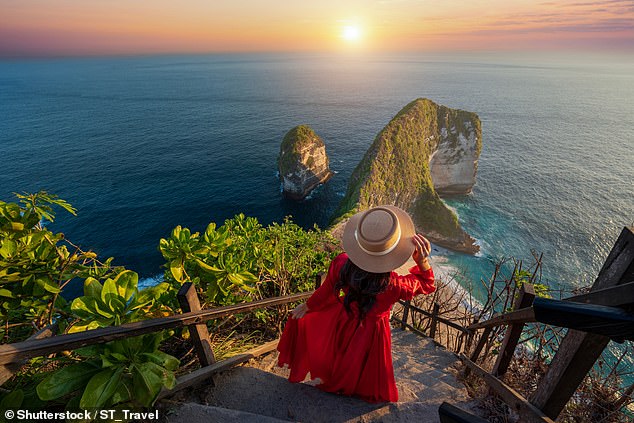After a summer of protests in Europe’s most popular holiday destinations against mass tourism and a growing concern about the erosion of natural environments, several places that were once considered desirable travel locations have been listed as places to avoid when booking a trip away.
Fodor’s Travels’ ‘No List 2025’ consists of ‘highly sought-after tourist spots (that) are collapsing under the weight of their own prominence’ and experiencing problems including overcrowding and environmental stress.
Destinations on this list include an island paradise turned ‘plastic apocalypse’, a driving route in Scotland and places in Europe where locals don’t want you.
These are the 15 places you should avoid in 2025.
Bali
The idyllic Indonesian island known for its beautiful beaches and lush landscapes has been highlighted as a top destination to avoid this year.
Fodor’s says: ‘Rapid, unchecked development fueled by overtourism is encroaching on Bali’s natural habitats, eroding its environmental and cultural heritage and creating a ‘plastic apocalypse’.

The idyllic Indonesian island known for its beautiful beaches and lush landscapes has been highlighted as a top destination to avoid this year.

Overtourism has turned Bali into a ‘plastic apocalypse’, says Fodor’s

Scavengers scavenge litter at Kedonganan Beach in Bali, Indonesia
Barcelona
The Spanish city known for its sunshine, thriving nightlife and stunning and unique architecture has become so oversaturated with tourists that locals have had enough.
Over the summer, locals were seen spraying unsuspecting visitors as they dined, while tens of thousands of protesters gathered in the city center demanding that tourists get out.
Fodor’s guide explains that visitors are arriving in such numbers that they are ‘clogging up neighbourhoods’ and ‘changing the fabric of society’, adding that ‘a good tourism management strategy should make immediate improvements in the lives of local residents.’
Because of this, it is best to avoid Barcelona this year, it says.

Protesters march and shout slogans against the Formula 1 Barcelona Fan Festival in downtown Barcelona, Spain, on Wednesday, June 19, 2024.
Venice
The Italian ‘floating city’ attracts masses of tourism every year thanks to its picturesque winding canals and striking architecture.
Just like Barcelona, locals don’t want tourists there.
Meanwhile, local authorities have taken measures to limit the number of visitors by introducing a tourist tax.
So it might be worth rethinking your trip to Venice this year.

‘No Big Ships’ activists stage a protest as the MSC Orchestra cruise ship departs Venice, Italy, Saturday, June 5, 2021

The Italian ‘floating city’ attracts masses of tourism every year thanks to its picturesque winding canals and striking architecture
Tokyo
The Japanese capital has become overwhelmed with tourists, with Fodor’s pointing out that the term ‘tourism pollution’ is increasingly being used by local media.
One of the major problems this has caused is an increase in domestic travel prices, as tourists stay in business hotels which then increase their prices.
Kyoto
Another Japanese tourist hotspot, Kyoto has become one of the world’s most sought-after travel destinations thanks to its vast array of Shinto shrines, Buddhist temples, palaces and gardens – some of which have become UNESCO heritage sites.
But as the guide points out, it is not possible to ‘easily’ walk into Kyoto’s ‘must-sees’, such as Arashiyama, Kiyomizudera and Fushimi Inari, as they are ‘overwhelmed by crowds’.

Kyoto has become one of the world’s most sought after travel destinations thanks to its vast array of Shinto shrines, Buddhist temples, palaces and gardens

Parts of Kyoto are overwhelmed by crowds
Majorca
Another Spanish destination that has earned a place on Fodor’s ‘no’ list is the sunny and picturesque island of Mallorca.
Thanks to its beautiful beaches, warm temperatures and a vibrant nightlife, the Mediterranean island has become particularly popular with British and German tourists.
But the pressure on local livelihoods is such that sentiment is increasingly anti-tourist.
Over the summer, anti-tourism protesters staged a series of protests demanding stricter regulations to control the influx of “low-quality” tourists flocking to the Spanish island.
In one particular case, 100 protesters, armed with banners and placards, stormed a popular party beach and told tourists to ‘go home’ while beachgoers soaked up the sun.

Members of the Mallorca Platja Tour association protest against tourist saturation with a banner saying ‘Let’s occupy our beaches!’ on the beach of Palma de Mallorca on August 11, 2024 in Mallorca, Spain

Over the summer, anti-tourism protesters staged a series of demonstrations demanding stricter regulations to control the influx of ‘low quality’ tourists flocking to the Spanish island
Koh Samui
Koh Samui in Thailand has long suffered from over-tourism,’ says Fodor’s, ‘but when the new season of The White Lotus begins in 2025, many fear what will become of the island.
‘Experts are concerned that the increased traffic will exacerbate existing problems on the island. There is currently 200,000 tonnes of waste in a landfill out of sight of tourist sites and luxury villas, as well as rapid, often unregulated, new development on the mountain face.’

Boats at the beauty beach with limestone cliff and crystal clear water in Koh Samui

A wave carrying plastic waste and other debris washes up on a beach in Koh Samui
Mount Everest
“Everest, known locally as Sagarmatha, Chomolungma or Qomolangma, is a sacred mountain for the Sherpa community, but over-tourism is adversely affecting local communities,” says Fodor’s.
‘It also degrades the environment and ruins travellers’ experiences.’
Agrigento, Sicily
The city is preparing to be the Italian Capital of Culture in 2025, which will likely mean an increase in the number of visitors, the guide says.
However, it notes that the area “faces a serious water crisis that could be further exacerbated by increased tourism, irrevocably damaging its most precious cultural treasures and punishing its permanent residents”.
Scotland North Coast 500
A surprising destination on the no-list is a driving route in Scotland, which has become extremely popular over the years.

Scotland’s North Coast 500 route has become ‘too popular’, says Fodor’s Travel
It threatened the natural environment as a result, and became a nuisance to the local communities living around it.
‘Camping in tents or mobile homes is one of the most popular ways for tourists to experience the NC500, but a lack of adequate facilities, including campsites, toilets and designated chemical waste areas, is causing problems along the route.
‘Wild camping on beaches, in lay-bys and even on private property is common, and residents report finding burn marks, litter, discarded grills and even human excrement in their wake,’ says the guide.





